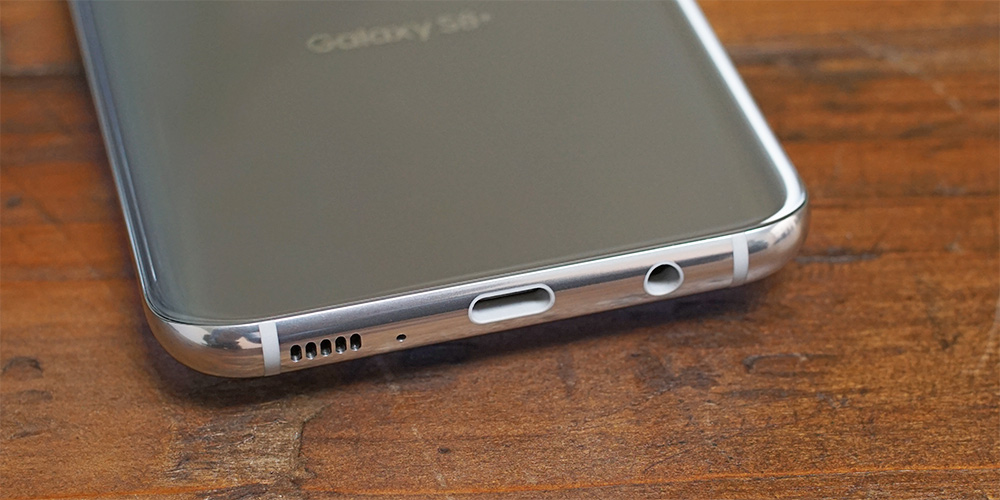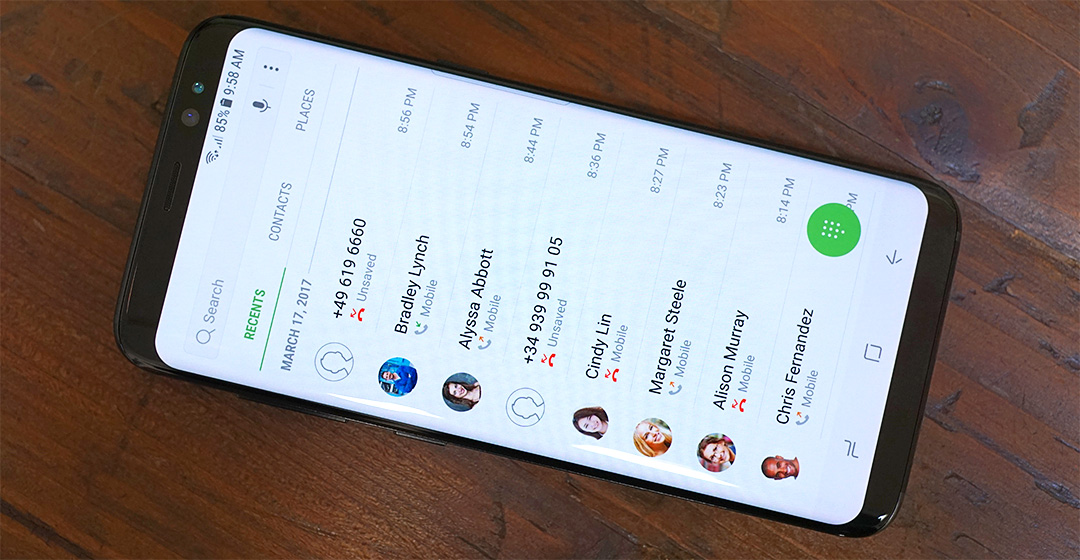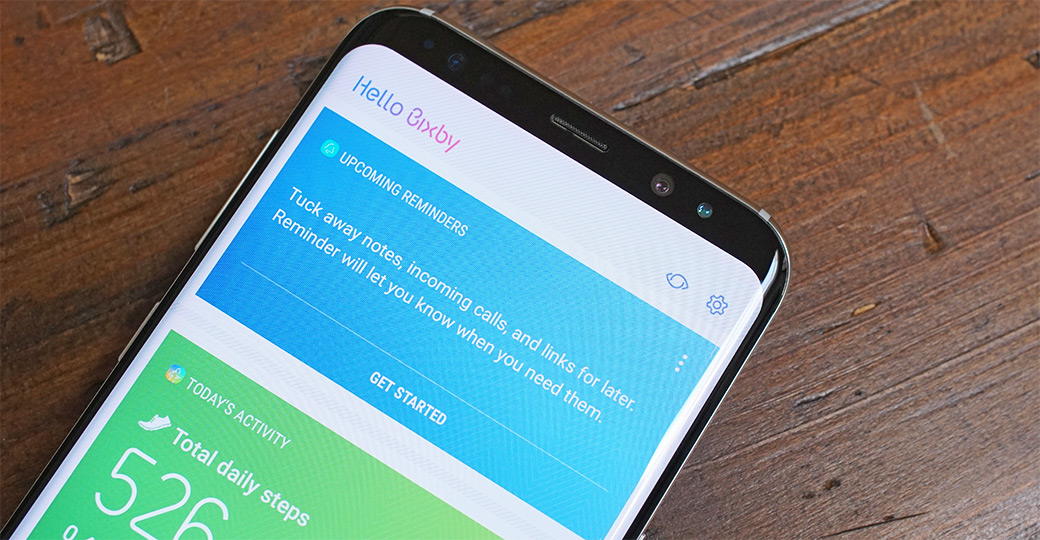Hands On With Samsung's Galaxy S8 and S8+: Taller Screens and Slimmer Bezels
by Matt Humrick on March 29, 2017 11:00 AM EST- Posted in
- Smartphones
- Samsung
- Galaxy
- Mobile
- Galaxy S8

Samsung officially unveiled the latest Galaxy devices at its Unpacked event in New York today. Previous Galaxy phones were part Porsche 911 Carrera, with an easily recognizable curvaceous style, and part Swiss Army knife, bristling with technology and features. This analogy holds true for the 5.8-inch Galaxy S8 and 6.2-inch Galaxy S8+, which share the same design DNA as the previous two generations.
The new phones’ aluminum frame remains sandwiched between edge-to-edge Corning Gorilla Glass 5, with curved sides on the front and back. The curved rear glass makes the phones easier to pick up and more comfortable to hold just as they did for the S7 and S7 edge, while the curved front glass—now standard on both S8 models—adds some visual flair.
There’s not much difference between the S8 and S7 along the sides either. The USB Type-C port on the bottom is flanked by a 3.5mm headphone jack and a single downward-firing speaker. The microSD/NanoSIM combo tray still resides on the top, and the thin power button is still a bit more than halfway up the right side. The only differences between new and old lie on the left side, where the volume buttons have been combined into a single rocker and a dedicated button for launching Samsung’s Bixby assistant makes its debut. Unlike the power button, I found myself occasionally pressing the Bixby button accidentally when picking up the smaller S8.
The most significant change is found up front, however, and it’s one that impacts both form and function. The Galaxy S8 and S8+ adopt Samsung’s new “Infinity Display” that stretches the screen vertically but not horizontally, deviating from the traditional 16:9 aspect ratio. The result is a QHD+ SAMOLED display with a 2960x1440 resolution and an 18.5:9 aspect ratio that’s very similar to the 18:9 aspect ratio display LG is using in its G6. Both Samsung and LG cite market research for this new display direction: People want larger screens that can show more content, but they also want phones that are useable with one hand and can fit in their pocket. The taller screen fits more content, so less scrolling, but keeps the phone narrow, so it’s easier to wrap your hand around.
Both S8 phones incorporate another emerging design trend: rounded display corners. Where LG’s G6 is using an LCD panel that actually has rounded corners, it appears Samsung is using a rounded bezel to cover the S8’s still sharp-cornered display. This avoids the aliasing that’s evident in the G6’s corners, producing a much smoother, nicer looking effect. While my time with the S8 was limited, it appears that TouchWiz and Samsung’s apps were redesigned to account for the rounded corners: Backgrounds extend the full height of the display and visual elements are still displayed along the top and bottom edges without getting cut off. Third-party apps, however, find their vertical dimensions constrained to the purely rectangular portion of the display, with the status bar above and the navigation bar below taking on black backgrounds.
The S8 and S8+ are also the first phones to receive the UHD Alliance’s Mobile HDR Premium certification that ensures a mobile device meets the minimum requirements for playback of 4K HDR video. This means that both S8s are capable of rendering at least 90% of the DCI-P3 color gamut, have a dynamic range of at least 0.0005-540 nits, and support a 10-bit display pipeline.
To keep the overall size of the phones in check, the S8/S8+ and G6 have dramatically reduced the bezel area around the taller screens. Samsung claims a screen-to-body ratio of 83% for its new Galaxy phones, less than the 91.3% of Xiaomi’s Mi MIX concept phone, but impressive nonetheless, especially considering how much hardware is located in the S8’s upper bezel. Besides the usual earpiece and proximity/ambient light sensors, there’s a new 8MP front-facing camera with f/1.7 lens and Smart AF that uses facial recognition for accurate focusing when taking selfies. There’s also an IR LED and IR camera for the iris-scanning security feature that made its debut on the ill-fated Galaxy Note7.
Shrinking the size of the lower bezel required relocating the fingerprint sensor to the back. Instead of placing it below the rear camera like we see on most other phones, Samsung places it next to the flush-mounted camera, which is less than ideal. Both the camera and the sensor are surrounded by a raised lip and are similar in size, making it difficult to locate the sensor by feel, and if your finger misses the sensor, you end up with a nice fingerprint on the camera lens. On the smaller S8, this issue may be mitigated with practice, but the problem is worse for the S8+. Being taller, it places the camera and sensor further from the lower edge, making it very difficult, if not impossible, to reach the sensor when holding the phone with a natural grip. Even with my larger-than-average hands, I struggled to reach the sensor without shifting my grip. I suspect people will turn to the iris scanner or the new face unlock feature, which uses the front camera for facial recognition after pressing the power button, to overcome the poor fingerprint sensor placement. The physical home button and capacitive navigation buttons, iconic Galaxy design features, have also been evicted in favor of the slimmer bezel, replaced by onscreen controls.



















208 Comments
View All Comments
lilmoe - Thursday, March 30, 2017 - link
The "misalignment" of the ports and buttons adds strength to the structure of the frame. Just like a brick wall. That's also objectively true...Symmetry, where it really counts is objectively best when it comes to industrial design. If said symmetry comes with compromise to the internal structure, then its meaningless.
negusp - Thursday, March 30, 2017 - link
There are plenty of phones with generally symmetrical placements of items on the back and very good durability.Your argument makes no sense. Why sacrifice ergonomics for maybe a very slight reinforcement which means almost nothing in that the entire phone is fucking glass?
lilmoe - Thursday, March 30, 2017 - link
Glass is there for a reason; better reception and wireless charging.The fingerprint scanner is there because time ran out while trying (with Synaptics) to incorporate it beneath the screen (according to reports).
My argument makes the most sense. They've been called out several times by iShills about the "misalignment" of the ports, yet are still there. The most obvious reason is structural integrity. What doesn't make sense is claiming that this alignment lacks "attention to detail". Damn, I get goosebumps just listening to that stupid, incomprehensible rhetoric.
But then again, if this oh-so-awful "misalignment" bothers you so much, you're free to ignore this phone altogether. But stop with the petty arguments.
Reflex - Thursday, March 30, 2017 - link
"I just tell how things are."For you.
marcolorenzo - Sunday, April 2, 2017 - link
I think you should stop with the metaphors, you're clearly not very good at them.close - Thursday, March 30, 2017 - link
@Reflex, sometimes I think ddriver is just fishing for compliments. For every 10 people laughing at him there will be one admiring his persistence in useless drivel and he'll eat that compliment up like there's no tomorrow.Why then even mundane products that have been around forever look very different from 10 or 20 years ago? Why are most cars or hairdos of the 80s considered garish today? Why over the years even preference in women has changed although you would assume something so basic would change at the rate of evolution? I won't even get into the many cultures that appreciate asymmetry and irregularity. Maybe they're not reading the correct comment sections...
Also I think he confuses the usefulness of a technology or the optimal placement of a component with aesthetics.
Practical = ergonomics. Aesthetics = beauty. And he'll have to ripen a little more before he stops trying to conclusively define "beauty" in exact terms and assume those terms apply to everything and everyone.
Shadow7037932 - Friday, March 31, 2017 - link
Do you really have nothing better to do with your life than constantly post comments on AnandTech?F1shbone - Thursday, March 30, 2017 - link
Do you have some inside knowledge to substantiate your claim that it would have been "very easy" to place the fingerprint reader and camera differently? Don't get me wrong, I agree with most people that a lower, centered placement for the reader would have been better, but I'm sure you agree that they must have considered that option. This leads me to believe that they had good reasons not to take that route. In short they had to give up that design win for other ones they valued more. And those other wins might have been practical, aesthetic, cost sensitive etc. Without having intimate insight into the design process there's really no way of knowing, but I tend to believe the decision to place the sensor more conveniently would most definitely NOT have been easy or otherwise they would have done it.negusp - Thursday, March 30, 2017 - link
@F1shboneI'm pretty sure they planned an under-screen design, but they had to rush the phone to market.
Thus we have a phone with very poorly-thought-out ergonomics. Typical sammy.
lilmoe - Thursday, March 30, 2017 - link
"poorly-thought-out ergonomics. Typical sammy."Exactly. Like how the S7 and Note7 are poor-thought-out. You believe they should wait several more months for Synaptics to finalize the below-screen sensor? You want them to incorporate a smaller battery for the sensor to fit in the middle like what LG did? Is this, by any way, worse than omitting the headphone jack to "incorporate a larger taptic engine"??? Laughable.
Just stop it guys. There isn't a phone out there with better ergonomics that has a crap-ton of best-in-class features with the least amount of compromise. It's just not technically possible ATM, but it should be when the Note8 is announced.